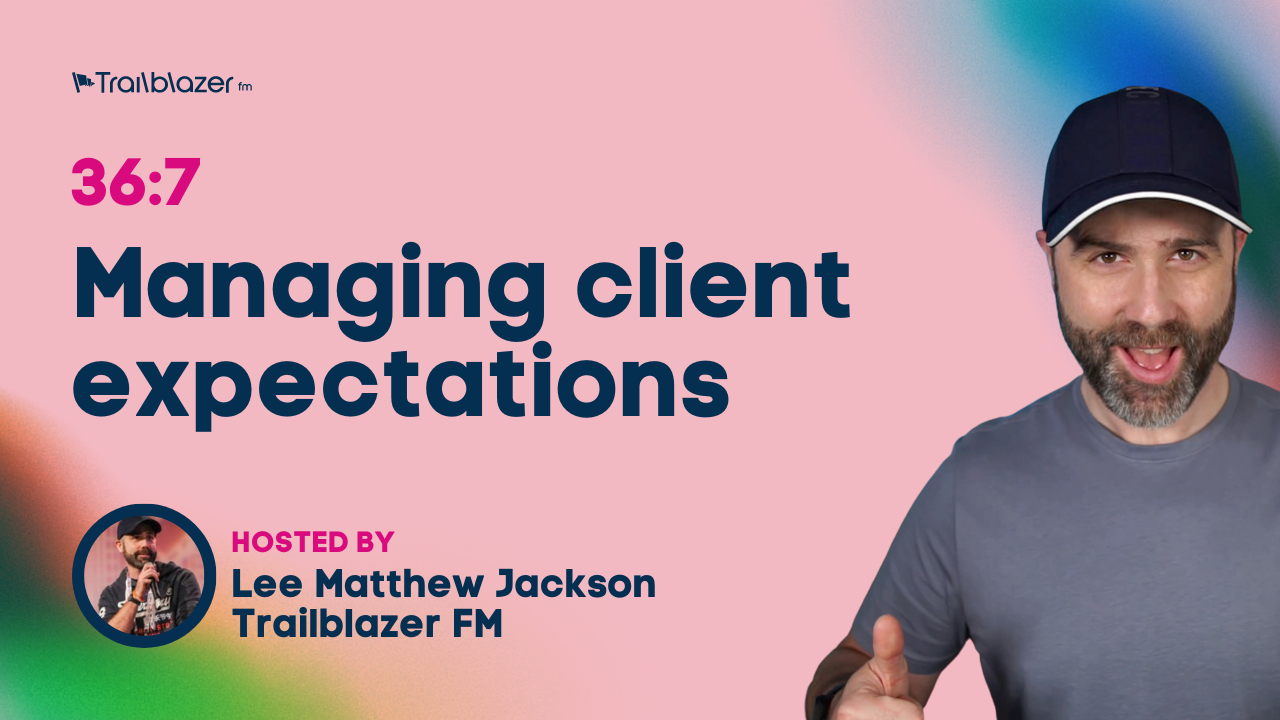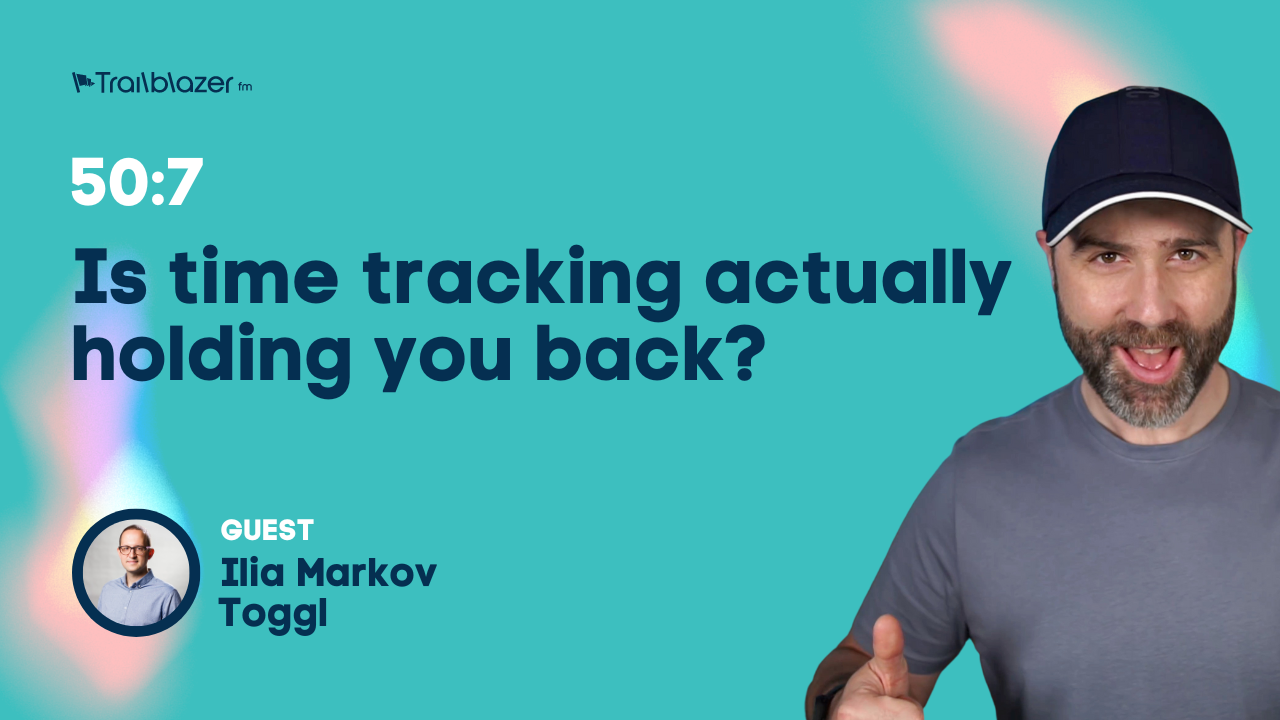
36:7 How to manage client expectations
So often our clients expect the world from us. Over time a line can be crossed and you find yourself at the beck and call providing help and support for things that are far outside your remit. What’s worse is you may even be doing this free of charge in order to keep your client happy.
So often our clients expect the world from us. Over time a line can be crossed and you find yourself at the beck and call providing help and support for things that are far outside your remit. What’s worse is you may even be doing this free of charge in order to keep your client happy.

This happens when we do not manage our clients expectations, and we allow them to make assumptions as to what they can expect from us. Today I will share with you four ways that we help establish and manage our clients so they understand clearly what we can and cannot do for them.
- List out key services in our initial proposal
- Ensure out of scope areas are discussed during discovery
- For extra services be strict on ensuring they are a “change control”
- Filter communications through a central form or support desk
Transcript
Welcome to the Agency Trailblazer podcast, this is your host Lee, and on today’s show, let’s talk about managing those client expectations.
Let’s set the scene. You have got a brand spanking new client. You’re really excited. You’re jumping into a phenomenal project with them and then things start to go wrong. First of all, you’ve built them this beautiful website. You’ve worked with them and they start to email you. And first, it’s OK. It’s just a little question about email or a little question about their computer. But before long, you become the de facto I.T. department for your client. Just because you know how to build a website does not mean that you are, in fact, and global I.T. genius, experienced with paper jams in printers, with email software, transferring of data and all of the other gubbons, which is frankly and clearly outside of the remit of your business.
So how can you manage your client’s expectations, ensuring that you offer the services that you are ultimately qualified to offer and to keep them happy, but also ensuring that you keep them off your back when it comes to all of the other crap that, frankly, you are not experienced with, is a major distraction and you should not be doing A at all, and B, especially not for free.
So if you have had this experience, I would recommend you stay tuned to this episode. You see, the first thing we do as a business is make sure we set those expectations really early on and we would meet with the client and start to understand what it is that they require for us. We predominantly build websites and we integrate into third party platforms through APIs so we can ensure that when we are quoting, we list out all of the services that we will be providing.
That means on our quote, we will provide the output that the client can expect. But it also means we will list out the actual services that we will be giving them. That means things like project management, development, design, and we would even attribute relevant staff members so people can understand the team that they are going to work with. They can see the line items on the quote. So I now understand I am going to have a five page website built and it will integrate into the Shopify API I’m making this up. We’ve never done that. And I will be receiving some design, some development and a project manager will be working with me on this project. I can also see who those people are.
So right from the get go before we’ve even engaged with money with this client, before we’ve even started to do our discovery or do any code. The client already has on paper the full expectations of what it is that this business can do for them.
So that would be our first step. And with that document, by establishing that right at the very beginning of the relationship, that’s something that we can always fall back on when the client tries to circle round with us and say, oh, do you mind awfully transferring all of our emails across to your server as well? Or do you mind awfully doing X, Y and Z?
The next step of our process is to go through discovery, so in discovery, we will ask some wider questions. We will take this the quote, we will lay the quote out and say, OK, we’re looking here at and often it’s not quite often it’s just a general proposal with a finger in the air estimate if we need to. And we will go through that discovery with them looking at each and every aspect of the site. They want to build the integration they need with, for example, Shopify, like we said in this case. But we’ll ask why the questions about their business, for example, we know they’re going to move their domain to a new server.
So we’re going to ask them about hosting and what are they doing about hosting? Are they expecting that from us? Do they have a hosting provider with hosting CMS email? So the next question would be, hey, you know, where is your email currently? Is that going to be affected in any way? And we can start to ask these wider questions.
I’d encourage you as well to ask questions about the infrastructure of the client. We will often ask, what computers do you have? Do you have windows? Are you using Macs? What’s your default browser across the company? Because that helps us ensure that we are doing all of our testing and helps us understand when there is a bug, how we can replicate that bug because we know how the client tends to access the content or the information that we sent. So all of these are really pertinent questions that you can ask. The important point of asking those is you can then set the client’s expectations with regards to who will be dealing with each one of those aspects, especially when it comes to things like mass transfer of email.
We would say at that point, well, I’m really sorry we don’t provide hosting and we certainly don’t provide email hosting. We can recommend cloud ways to you and we can manage that process. And that would be a separate line item where we manage it. But you would build it. You would sorry, you would pay the bill. On the flip side for email. We don’t manage that at all. We don’t do transfers or integrations. But we can recommend you, Joe Bloggs or Jane Doe over here who can support you with that.
And if you’d like us to make an introduction for them to give you a quote for that, please let us know. Otherwise, if you’re moving across to Gmail or whichever, there’s certain services that will help with that process.
In fact, I’m pretty sure some hosting providers even offer that as a service to help people fully migrate over. But that’s the purpose of having that conversation inside of the Discovery meeting. We’ve set some of those expectations in that initial quote or proposal, whatever we’ve sent them as the initial, hey, do you want to do the dance? And during the discovery, we’ve gone deeper and continued to set those expectations.
Now, sometimes, no matter how good you are at setting those expectations up front, you may find clients are still coming to you for things that are, frankly, out of your remit, and they can expect that you will drop everything and help them for free. It might be an I.T. issue. It might be the paper jam that Robey was joking on the life that we are actually doing this podcast episode on. It might be a big email transfer, and at that point I can have a conversation with the client and do one of two things I can say. I’m really sorry we don’t offer that service, but we can help find the right person. I can recommend X, Y and Z. Or alternatively, if you have capacity, this is something you can do, but you don’t want it to affect your business and your bottom line that I would use what’s called a change control.
That means you can say, yes, we can provide you this service. It is not something that we laid out in that initial offer. It is not something that we agreed to during the discovery. Therefore, this is a change control item. And whilst we can do it, it isn’t our specialism. It will take us extra time. We will need all of that time covering. And we believe the cost is going to be in excess of X, Y, Z, whatever that cost is going to be.
You will find in many circumstances that at that point the client will respect the fact that this is something that is a change control, that is costed, that will take time, that has value to them and needs to be paid for. And secondly, may find they want to go elsewhere to find it cheaper, which in most circumstances, as far as I’m concerned, is absolutely fine because I don’t really want to be transferring gigabytes and gigabytes of data.
Finally, when setting client expectations, we like to educate them as to how to connect with us. We don’t want people picking up the phone unnecessarily unless they’re paying for that sort of access. We don’t want people what zapping us? We don’t want people messenger messages during us. We don’t want people spamming individuals on email. So we are very clear about what the process is for communication. If we’re working on a project, then we are working within the project management system and within that project management system we’ve already laid out all of the services, everything that they’re going to get. So they fully understand it. They can see all of the related tasks and they can communicate with us in there. And if something they ask for is out of scope, then we can easily highlight that. But secondly, we would encourage clients who then need ongoing support to connect with us through a support form. We use our table. We’ve got an integration that puts that where we need it and we can deal with that.
And that form ensures that questions are pre qualified. We list out in that form. The services that we are offering is your question about Web design development, a bug and so on and so forth. We’ve listed out the services that we offer so our client knows that that question needs to be relevant if they select other and then give us some random question. That’s fine. We’ve already established in in their mind that this is something beyond the list of questions that we would normally expect, and that gives us easier recourse for when we respond, saying we’re awfully sorry, but we don’t provide support for that particular product or service.
So I would highly encourage you to find some sort of centralized method that you can receive client communication from rather than just being blitzed with emails and telephone calls about things that are not necessarily related to either the project or the products and the services that you have to offer.
I found over the years as an agency owner that these four steps are highly effective at managing client expectations were in the past. I used to let things get out of control. We found ourselves taking responsibilities for our clients IT infrastructure. Nowadays we are able to draw a line and make it very specific what we do, what we offer and how we can support our clients.
Back in the old days, it was immensely stressful because we felt we needed to keep pleasing our client. That is because our client had an inflated expectation of what we could do for them. When we set those expectations right at the very beginning, anything beyond those expectations are easy to push back on. It’s easier for you to say we do not offer that when you’ve already made it in. Well, clear, right at the very beginning.
So a reminder of those four steps. The first thing we will do is in any quote or in any proposal that we send out, we will be listing out what they will be getting in reform, but also the services that we will be offering with those like design development, project management, so on and so forth, UX, consultancy, whatever services you offer, make sure you list them out very specifically. Therefore, email transfer or anything beyond that is not in the list.
Next, during the discovery, we would then have the wider conversation about the business, highlighting any questions that we believe are important, like do you have an email provider, do you have a hosting partner? And so on and so forth, so that you. And make it clear what you do and what you don’t do and what the client needs to go ahead and source.
Next, if a client still wants to push for something that is outside of your remit, A, you can just say flat out no, or, B, you can offer that as a change control if you have the capacity, if you are able to do it and you wouldn’t mind the billing, then short put that out as a change control. And we found in most circumstances when we do that, because we’re probably more expensive than somebody who specializes in it, the client tends to go away and finds someone else to do it, which is totally fine by us.
Then finally, we manage the way that clients communicate with us. We don’t have them emailing us. We don’t have them going through WhatsApp and Messenger and all sorts of telephone calls. We have them going through a very specific form which forces them to select the topic that they want to ask questions on or get more information on and those are essentially the core services that we offer. That means when they select other and put something that is really not related to what we do, we’ve already established that that’s outside of those services and it’s far easier for us to go back to them with a hey, we don’t do that, but we can help you find the person who will.
So, folks, how do you manage your client expectations? Have you found yourself in the exact same situation? You have too many emails, too many phone calls, and you find yourself being a client pleaser rather than controlling that relationship.
If you do feel like that, I would encourage you to take a look at the notes of this episode and see if you can begin to apply those sorts of methodologies to your business practice. Setting those expectations. You can start as soon as your website get those services on your website, get those services listed out in your proposal or in your quotes, get those services nailed again during that discovery and then during your communications, etc having your client understand what your specialisms are and anything out of that scope, you will need to push them in a different direction.
If you’ve had any of these experiences, if you have any thoughts or advice, please join our community over on trailblazer.fm/group is a great place for us all to hang out together and to ask these all important questions and brainstorm together. That’s trailblazer.fm/group. And finally, this episode was sponsored by Cloudways, my all time favorite hosting company who make getting an agency into the cloud ridiculously easy. You can check them out over on Cloudways.com or the show notes of this episode for any offers that may be on at this particular time.
Folks, if we don’t see you in the community, we will see you in next week’s episode.








